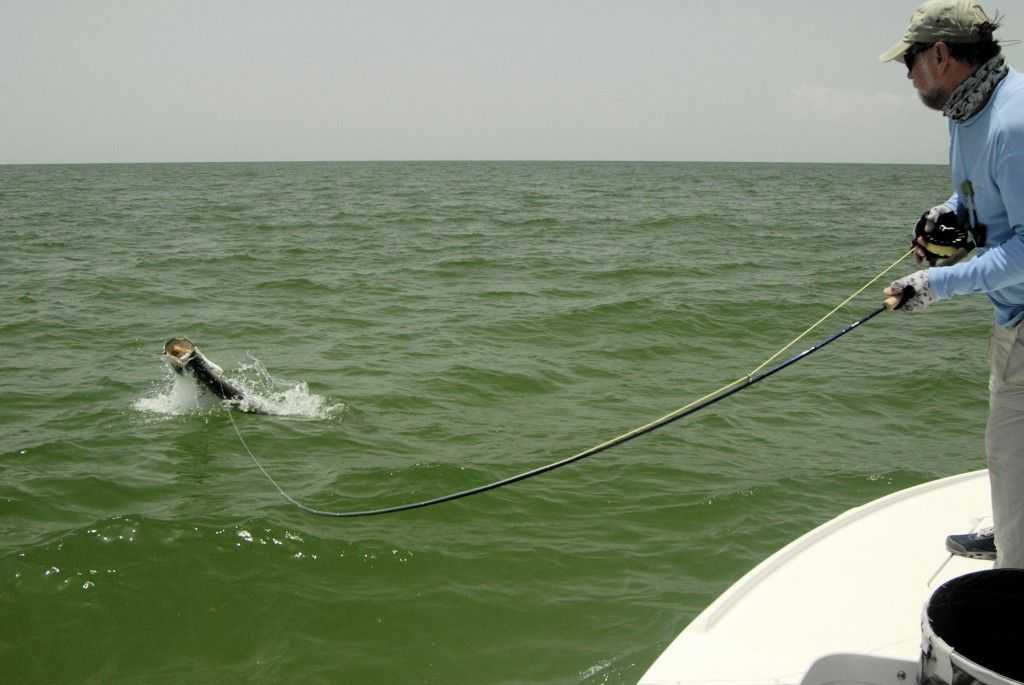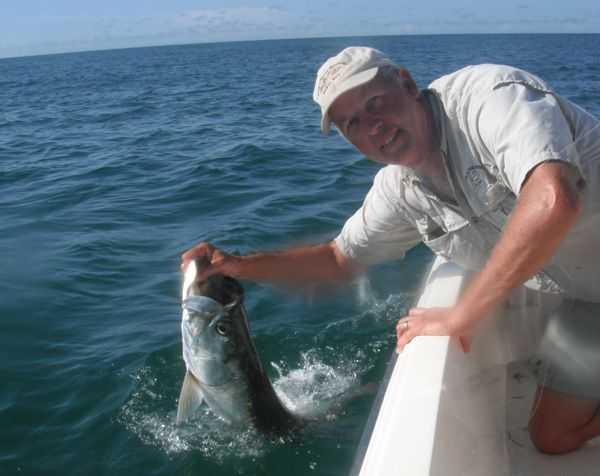By Capt. Jim Klopfer

In the pre-dawn twilight it was difficult to see the fish, but they were there. Just barely perceptible was a little slick that just did not look right. “Get ready” the captain whispered, “they are going to pop up right in front of us.” Several anxious moments passed before the fins and tails of a couple dozen hundred pound tarpon broke the flat calm surface of the Gulf of Mexico.
“Cast out six feet in front of the fish, make sure you don’t throw on top of them,” the guide advised. The crab landed several feet in front of the pod—it was an excellent cast. Both watched in anticipation as the crab slowly sank. After several seconds, the line gradually became taut.
“Reel!” the guide hollered, unable to hide his excitement. The angler reeled as fast as he could while raising the rod tip high. The line angled towards the surface as the fish made ready to leave the Gulf. One hundred pounds of silver fury cleared the surface by a good four feet, crashed into the water, and ran off on another burst before leaping once again, this time throwing the hook. Disappointment soon turned to admiration—what a fish!
That is a commonly played out scenario off of Sarasota beaches from late spring through early summer. While saltwater fishing is very good all year long, there is something magical about tarpon fishing. This is truly world class angling. Very few places on earth offer anglers the opportunity to sight cast to fish this large using spinning or fly tackle. Many more tarpon are hooked than are actually landed. In fact, most Sarasota guides put more emphasis on stalking and hooking these behemoths than in actually landing them. The old saying, “It is the bite, not the fight,” certainly applies.

The fish generally show up in early May and are here in significant numbers by the third week in May. Early in the season the schools can be huge, numbering in the hundreds. Later in the season they break up into smaller pods. By late July the fish have thinned out considerably, but so has the fishing pressure. Fish late in the year don’t show as well but they bite better. These fish are here on their annual spawning run and that is their priority, not feeding. There are days when we are all over the fish and don’t get bit. The next day you might see a school and catch several out of it.
This is as much fish hunting as fishing and certainly requires patience along with the right mindset. It is truly big game fishing, and extremely challenging; there will be unsuccessful days. But, the thrill of hooking and landing a fish over one hundred pounds in clear water sitting just offshore of our pristine beaches makes the time invested worthwhile. Most trips result in at least a couple of fish jumped.
The vast majority of tarpon hooked off the Suncoast beaches are done so using heavy spinning tackle and live bait. A two-three-inch live de-clawed crab is the most popular bait. They cast well, live for quite a long time, and tarpon love them. Live baitfish such as pinfish, threadfin herring, large pilchards, cigar minnows, and blue runners are caught on Sabiki rigs and catch plenty of fish, too.
Boats arrive on-station just before first light and sit quietly a hundred yards off the beach. Clients and guides scan the calm Gulf waters intently, searching for signs of fish. Often times, it is just a subtle disturbance on the surface, and other times there is no mistaking it as a dozen huge fish roll and flash silver on top. Schools that are showing well and moving slowly are the best ones to target. Electric trolling motors are used to position the boat within casting range. The anticipation during these moments is incredibly exciting. If all goes well, the fish pop up within range and the baits are cast out ahead of the fish. When the line gets tight, the fun begins. Battles can last for a few minutes or a few hours.
Catching one of these behemoths is never easy, but getting one on fly is the ultimate angling challenge. Conditions must be just right and a fair amount of skill is required to cast and present the fly. Slow moving schools will take a fly early and mid-season. Later in the season, after the large schools have broken up, the fish are caught on shallow bars near the passes. These fish do not surface but instead are cast to “Keys style.” The dark shapes show up against the white sand and on a good day an angler can expect a couple dozen shots.
If the opportunity presents itself, don’t pass up the chance to experience the thrill of a lifetime—sight casting to giant tarpon!
Capt. Jim Klopfer owns Adventure Charters in Sarasota, FL and has been a fishing guide since 1991. He has a wide variety of angling experience and caters his charters to the experience level of his clients, from catching trout and Spanish mackerel on the flats to sight fishing for giant tarpon on fly. He also offers freshwater trips for bass, bluegill, and snook. He can be reached at (941) 371-1390 or captklopfer@comcast.net
[easy-social-share]